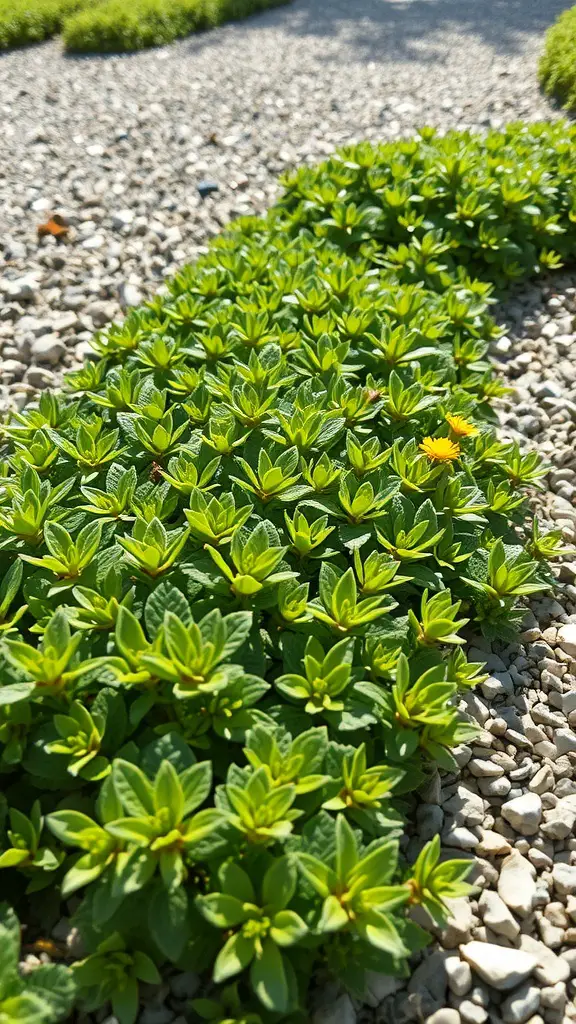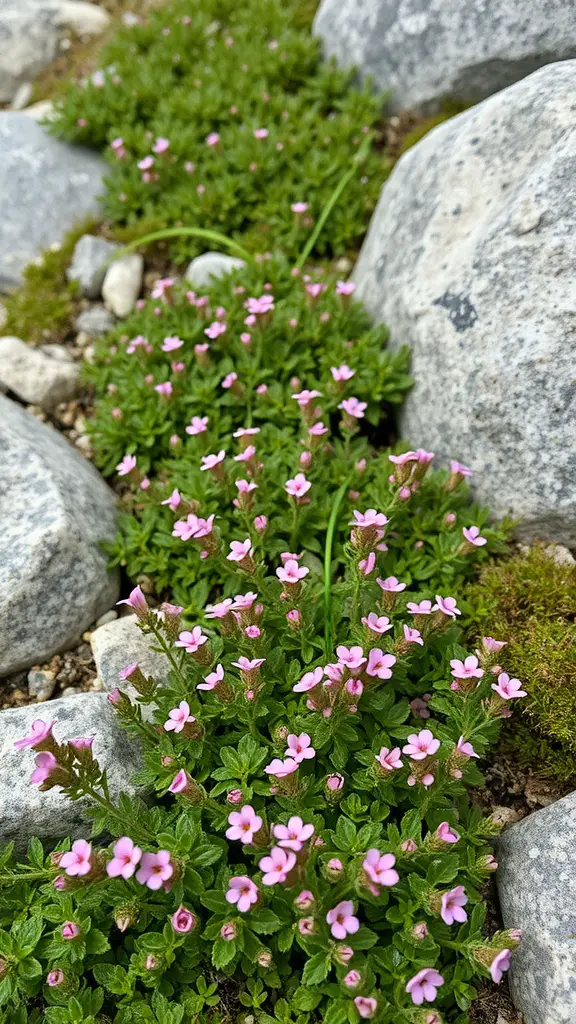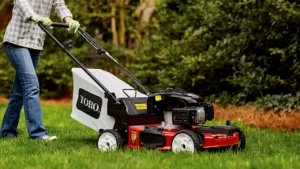Ground cover plants are a fantastic way to enhance your garden while minimizing maintenance. They create a lush, green carpet that suppresses weeds, holds moisture, and adds beauty to any landscape. Here are 21 ideas that showcase versatile and attractive ground covers to inspire your garden choices.
Vinca Minor: A Resilient Choice

Vinca minor, often known as periwinkle, makes a fantastic ground cover plant. The image shows a lush display of vibrant purple flowers set against rich green leaves. This combination adds a delightful splash of color to any garden.
One of the great things about Vinca minor is its ability to thrive in various conditions. Whether in full sun or partial shade, this plant adapts well. It’s low-maintenance, making it an excellent choice for busy gardeners.
This plant spreads quickly, creating a beautiful carpet of blooms. Its hardy nature means it can withstand drought, which is perfect for those hotter months. Plus, it can help control weeds by covering the ground.
With its charming flowers and resilience, Vinca minor is a solid choice for any garden. It not only enhances the beauty of your outdoor space but also provides functional benefits.
Ground Morning Glory for Quick Coverage

The Ground Morning Glory is a fantastic choice if you want to add quick coverage to your garden. Its vibrant flowers bloom in shades of purple and red, bringing an instant pop of color. This plant is not just pretty; it’s highly effective at covering bare spots and creating a lush look.
These flowers thrive in sunny areas, making them perfect for bright garden spots. They grow rapidly, which means you won’t have to wait long to see the results. Plus, the heart-shaped leaves add a lovely texture to your landscape.
Ground Morning Glory is also quite low maintenance. Once established, it doesn’t require much water. Just make sure it has well-draining soil, and you’ll see it flourish. This plant can spread quickly, so keep an eye on its growth to ensure it doesn’t take over your garden.
Ajuga: The Colorful Ground Cover

Ajuga, often known as bugleweed, is a fantastic choice for ground cover. The image beautifully showcases its vibrant blue and purple flowers, standing tall above lush green leaves. This plant can bring a splash of color to any garden, making it a popular pick for gardeners.
The flowers bloom in dense spikes, creating a striking appearance. Ajuga thrives in various conditions, from sunny spots to partially shaded areas, making it quite versatile. Its ability to spread quickly also means it can cover bare spots in no time.
Beyond its beauty, Ajuga is low-maintenance and resistant to many pests, which is a bonus for any gardener. It pairs well with other plants, enhancing the overall look of flower beds and borders. If you’re looking for a colorful and resilient ground cover, Ajuga is definitely worth considering!
Sedum: Drought-Resistant Beauty

When you think of ground cover plants, Sedum is a standout option. This vibrant plant thrives in various conditions, making it perfect for any garden. The image showcases a stunning array of Sedum varieties, bursting with color and life.
In the picture, you can see different shades of green, pink, and red, which add a playful touch to the landscape. Sedum is known for its succulent leaves and flowers, which draw attention and provide a warm, inviting feel. These plants are not just pretty; they’re also tough. Sedum can withstand dry spells, making it an excellent choice for areas with less rainfall.
Planting Sedum is easy. Just choose a sunny spot, and they’ll flourish with minimal care. They’re also great for rock gardens, retaining walls, or as a border. Using them in your garden will add texture and a pop of color without requiring much effort.
Creeping Jenny’s Golden Charm

Creeping Jenny, or Lysimachia nummularia ‘Aurea’, is a delightful ground cover plant that brightens any garden. Its vibrant yellow leaves create a cheerful scene, especially when paired with darker stones or mulch, as shown in the image. This plant is perfect for adding a splash of color to those tricky spots in your landscape.
One of the best features of Creeping Jenny is its ability to thrive in various conditions. Whether your garden has sun or shade, this plant will adapt and flourish. It spreads quickly, making it an excellent choice for filling in bare patches or preventing weeds. Not to mention, it produces lovely yellow flowers in spring, further enhancing its charm.
When planting Creeping Jenny, keep in mind that it can spread quite a bit. Regular trimming helps maintain its shape and prevents it from overtaking other plants. Consider using it along pathways or as a border to create a stunning visual appeal. With its golden hue, this plant truly shines, making your garden feel more inviting.
Creeping Thyme for Fragrant Lawns

Creeping thyme is a wonderful choice for anyone looking to create a fragrant lawn. Its tiny purple flowers and lush greenery spread beautifully across the ground. In the image, you can see a vibrant carpet of creeping thyme blooming, bringing life to the surrounding garden.
This plant is not just pretty; it offers a lovely scent when walked upon. Imagine strolling through your garden and enjoying the fresh aroma released by the leaves. It’s like a natural air freshener right in your backyard!
Creeping thyme also thrives in various conditions. It’s drought-resistant, making it perfect for sunny spots where grass might struggle. This hardy plant requires little maintenance, making it an excellent choice for busy gardeners.
Besides its beauty, creeping thyme is great for attracting beneficial insects, which help pollinate other plants in your garden. Planting it can boost your garden’s overall health while adding a splash of color.
Moss: The Natural Floor Cover

Moss is a fantastic ground cover plant that brings a natural look to any space. Its lush, green texture creates a soft carpet that feels inviting underfoot. This image shows moss in a vibrant, rich green color, surrounded by ferns and leafy plants. The contrast of textures adds visual interest and enhances the beauty of the garden.
One of the great things about moss is its ability to thrive in shady areas where grass might struggle. This makes it an excellent choice for those tricky spots under trees or in corners that don’t get much sunlight. Not only does it look good, but it also helps to retain moisture in the soil, which can benefit surrounding plants.
Taking care of moss is relatively easy. It prefers a moist environment and can often be maintained just with occasional watering. Unlike grass, it doesn’t need mowing, making it super low-maintenance. Plus, moss can help prevent soil erosion on slopes, making it a practical choice as well.
If you’re considering adding moss to your garden, think about combining it with other plants. The image highlights how moss can work beautifully alongside ferns, creating a lush, layered effect. It’s a simple way to add depth and character to your outdoor spaces.
Blue Star Creeper for a Soft Touch

Blue Star Creeper is a delightful ground cover that brings a soft, peaceful vibe to any garden. Its vibrant blue flowers create a stunning carpet-like effect, making paths and garden spaces feel inviting. The image showcases a beautiful pathway bordered by lush clusters of this lovely plant, which adds charm and color.
This plant thrives in various conditions, making it a versatile choice for different landscapes. It can handle foot traffic well, which is great for walkways. Plus, its low-growing nature means it won’t overshadow other plants, allowing you to create a harmonious garden design.
Incorporating Blue Star Creeper into your garden can enhance the overall look while providing a soft touch underfoot. It’s easy to maintain and can spread quickly, perfect for filling in gaps in your garden. Whether you’re creating a serene retreat or a vibrant garden path, this plant will add that special touch you’re looking for.
Creeping Phlox for Spring Color

Creeping phlox is a fantastic choice for adding a burst of color to your garden in the spring. This lovely plant creates a vibrant carpet of bright pink and white flowers that can instantly lift your outdoor space. The lush green foliage complements the flowers perfectly, making it a visually appealing option.
These plants spread beautifully, filling in bare spots and preventing weeds. They thrive in sunny areas, making them ideal for rock gardens, borders, or even hanging over walls. Caring for creeping phlox is simple; just ensure they get enough water, especially in dry spells.
With their cheerful blossoms, creeping phlox not only beautifies your garden but also attracts pollinators, adding life and movement. If you’re looking to brighten up your yard, consider planting creeping phlox this spring!
Liriope: The Grass-Like Accent

Liriope, often called monkey grass, brings a unique touch to any garden. The image shows lush green foliage paired with tall spikes adorned with purple flowers. This combination makes it an excellent choice for ground cover.
This plant thrives in various conditions, from shady spots to sunny areas. It’s known for its resilience, making it perfect for low-maintenance gardens. The grass-like leaves create a soft texture that contrasts beautifully with vibrant blooms.
Growing Liriope can fill spaces effectively, preventing weeds while adding visual interest. Its flowers attract pollinators like bees and butterflies, contributing to a lively garden atmosphere.
Consider planting Liriope along pathways or borders to define spaces elegantly. Its versatility allows it to blend well with other plants, enhancing the overall look of your garden.
Herniaria Glabra: The Hardy Survivor

Herniaria glabra, better known as rupturewort, is a remarkable ground cover plant. Its vibrant green leaves create a lush carpet that thrives in various conditions. This image showcases its ability to flourish among gravel paths, highlighting its versatility.
Rupturewort is a champion of survival. It can tolerate drought and poor soil, making it an excellent choice for low-maintenance gardens. The small, yellow flowers that may occasionally pop up add a splash of color, offering a cheerful touch to any landscape.
This hardy plant spreads quickly, filling in gaps and preventing weeds from taking over. Its dense growth not only beautifies but also protects the soil underneath. If you’re looking for a reliable ground cover that can withstand the test of time, Herniaria glabra is a solid pick.
Thymus Serpyllum: The Wild Thyme

Thymus serpyllum, commonly known as wild thyme, is a charming ground cover plant. It thrives in rocky areas, often seen spilling over stones. This image beautifully captures the delicate pink flowers dotting the lush green foliage, creating a lovely contrast against the rugged rocks.
Wild thyme is not just visually appealing; it’s a low-growing herb that can fill spaces in your garden effortlessly. It’s perfect for pathways or as a filler between stones. With its fragrant leaves, it’s also a delightful addition to culinary dishes, enhancing flavors in various recipes.
Growing wild thyme is straightforward. It prefers well-drained soil and a sunny spot. Once established, it requires minimal care. This plant is drought-tolerant, making it an excellent choice for gardens in dryer climates.
Clover: The Eco-Friendly Option

Clover is a fantastic ground cover plant that offers both beauty and benefits. With its lush green leaves and delicate white flowers, it adds a charming touch to any garden. This image showcases a vibrant patch of clover, demonstrating how it can create a lovely, natural-looking carpet of greenery.
Not only does clover look great, but it is also incredibly eco-friendly. It’s a nitrogen-fixing plant, which means it helps improve soil health by adding nutrients back into the earth. This can reduce the need for chemical fertilizers, making it a sustainable choice for gardeners.
Another great aspect of clover is its ability to attract pollinators like bees. This makes it an important player in supporting local ecosystems. Plus, clover is hardy and drought-resistant, making it low-maintenance and perfect for a variety of climates.
So, if you want a beautiful and environmentally friendly option for ground cover, consider planting clover. It’s a win-win for your garden and the planet!
Creeping Raspberry for Edible Ground Cover

Creeping raspberry is a delightful choice for anyone looking to add both beauty and functionality to their garden. With its lush green leaves and vibrant red berries, it offers a stunning visual appeal. This plant not only serves as a ground cover but also produces delicious, edible fruit that can be enjoyed fresh or used in various recipes.
The image shows a healthy patch of creeping raspberry, showcasing its abundant clusters of red berries nestled among the green foliage. These berries are not just pleasing to the eye; they are sweet and tangy, perfect for snacking or adding to desserts. Imagine picking fresh raspberries right from your garden!
Creeping raspberry thrives in a variety of environments. It can handle partial shade and is relatively drought-resistant once established. This makes it a versatile option for different garden settings. Plus, it spreads easily, helping to suppress weeds and maintain soil moisture.
If you’re interested in incorporating creeping raspberry into your garden, consider planting it in a location where it can spread without crowding out other plants. The berries typically ripen in late summer, giving you plenty of time to enjoy your harvest. Just be sure to keep an eye out for birds, as they love these tasty treats too!
Carpet Bugleweed for Shade Areas

Carpet bugleweed, or Ajuga reptans, is a fantastic choice for those shady spots in your garden. This plant displays beautiful clusters of blue flowers that add a lovely pop of color to areas that often get overlooked.
In the image, you can see vibrant blue flower spikes rising above deep green foliage. These flowers create a stunning carpet effect, making your garden feel lush and inviting. The contrast between the flowers and the leaves enhances the overall aesthetic, offering a refreshing look.
Carpet bugleweed thrives in partial to full shade, making it perfect for under trees or in other shaded areas. It’s also low-maintenance and spreads easily, which helps fill in bare patches quickly. Plus, it’s a great option for controlling erosion on slopes.
If you’re looking for a ground cover that will brighten up your shady spots, carpet bugleweed is a wonderful pick. Just make sure to keep an eye on its spread so it doesn’t take over the garden!
